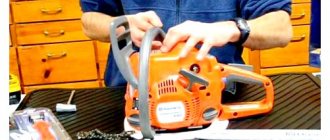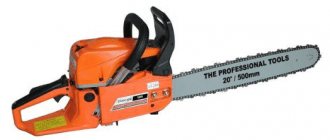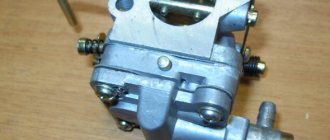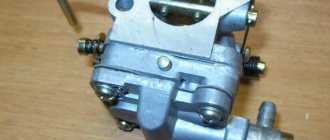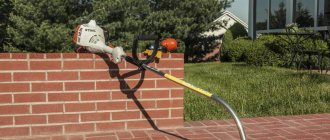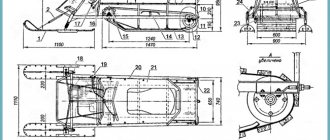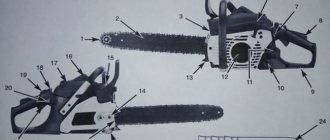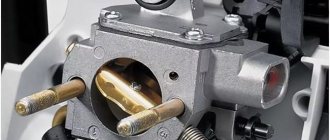A chainsaw is needed in construction, gardening, and landscaping - its presence greatly simplifies the performance of a number of wood processing tasks. The main component of this tool is the engine, the operation of which largely depends on the condition and settings of the carburetor. This is where the fuel mixture is prepared. This means that if the saw does not start, stalls, or does not provide the required power, it is likely that the reason for this is improper operation of the carburetor. Fortunately, in many cases you can deal with this on your own. Only for this you need to know and understand the structure and operating principle of this unit and, of course, the chainsaw itself.
- 2 Why is primary adjustment needed?
- 3 How to recognize carburetor failures?
- 4 Do-it-yourself disassembly: nothing complicated
4.1 Disassembling the chainsaw carburetor in the photo
How does a chainsaw carburetor work?
The main purpose of a carburetor is to mix fuel with air in the required proportions. If the latter are violated, this almost instantly affects the operation of the engine.
Chainsaw carburetor Stihl MS 181 C BE
Chainsaw carburetors may differ in design. However, their basic elements and operating principle remain approximately the same.
Carburetor design:
- The basis
This is a wind tunnel, across which there is an air damper - with its help the intensity of the air supply is regulated.
- Diffuser
This part is where the base tube narrows - here the air flow speed increases, i.e. air is always supplied to the carburetor under some pressure.
- Spray
In this area, the fuel comes into contact with the air flow. Fuel enters the atomizer from the float chamber through a nozzle (dispenser).
- Float chamber
This is a container that allows you to keep the fuel mixture in a stable state.
Chainsaw carburetor design diagram
A chainsaw carburetor works according to the following principle:
- when the engine starts, the main damper opens and a stream of air is supplied into the air channel at a certain speed;
- the speed of the air flow, as well as the level of the float in the chamber, are regulated by the position of the damper, namely due to the difference in pressure in the float chamber and the air channel;
- fuel from the float chamber is sucked into the nozzle, and from there into the diffuser;
- passing through the diffuser, the air captures the fuel entering there;
- the resulting mixture is fed into the cylinder cavities through the intake channels.
The principle of operation of a chainsaw carburetor
The pressure in the float chamber is approximately equal to atmospheric pressure, but a vacuum occurs in the air channels of the carburetor when the chainsaw engine starts. Opening the damper increases the air supply intensity. As a result, more fuel enters the carburetor, and the number of engine revolutions increases.
The design and principle of operation of a chainsaw carburetor
The chainsaw carburetor consists of the following main components:
- one-piece body made of light aluminum alloy;
- a diffuser located at the entrance to the carburetor;
- jets, special valves designed to regulate the supply of a combustible mixture;
- sprayer;
- float chamber.
Below is a diagram of a Walbro carburetor, which is very often equipped with chainsaws. Using this diagram, you can study in more detail the internal structure of the chainsaw carburetor.
The carburetor may have 2 or 3 adjusting screws with springs. The adjusting screws are designed so that there are needles (cones) at their ends. The screws have a right-hand thread, that is, they are tightened clockwise.
The chainsaw carburetor works as follows.
- After starting the engine, the air damper opens.
- In the diffuser (16), where there is a narrowing, the air flow accelerates and mixes with gasoline. The latter enters through jets (15) and (12), and the air purified by the air filter comes through the damper (7) located at the diffuser inlet.
- The damper (8), located behind the diffuser, regulates how much of the prepared mixture enters the combustion chamber.
- The volume of gasoline passing through the nozzles is regulated by screws (17) and (10) - these are, respectively, screws L and H on the chainsaw.
- The volume of the fuel mixture in the float chamber (14) depends on the needle valve (11). The functioning of the needle valve is controlled by a diaphragm (13).
- The membrane (4) controls the flow of the fuel mixture into the combustion chamber, and this depends on the number of revolutions of the internal combustion engine. Gasoline is purified through a filter (6).
Why is primary adjustment needed?
During the first hours of operation, the 2-stroke chainsaw engine requires running-in, on which the quality of its further operation depends. During the running-in process, the carburetor is initially adjusted - the optimal parameters for preparing and supplying the fuel mixture are established.
Initial running-in of the chainsaw: working with thin material
Most modern chainsaws are sold adjusted. However, it doesn’t hurt to check the quality of the factory settings - in the end, it’s you who will have to work with the tool.
When starting up for the first time, the chainsaw should operate in a gentle mode. Therefore, for several hours after start, it is recommended not to overload the engine and cut only small branches and trunks up to 10 cm thick.
Simple rules will help you insure against malfunctions of the chainsaw carburetor:
- Always mix gasoline and oil according to the manufacturer's instructions.
Proportions of the fuel mixture for a chainsaw engine - Do not prepare the fuel mixture in advance - the properties of gasoline and oil in a mixed state are lost over time. The exception is fuel for intensively used tools, however, even here the norm should not exceed approximately a week.
- Use oil designed for your chainsaw engine. A fuel mixture with a non-standard composition will seriously and permanently disable it.
- When preparing the fuel mixture, take into account the influence of climatic conditions on its components.
The chainsaw must start correctly, ensure a stable rotation speed of the sprocket and a smooth increase/decrease in power. There should be no extraneous knocks, pops or noises when the engine is running.
Professional hand chainsaw at work
The main thing during the initial running-in of the tool is to ensure that the fuel consumption corresponds to the power used, i.e. in practice, the saw should not go out, “sneeze”, smoke or run jerkily.
What type of carburetor is used in modern chainsaws
All modern chainsaws use membrane-type carburetors. They were developed by German designers of the world's leading chainsaw manufacturer Stihl in the mid-50s of the last century and revolutionized the design of chainsaws.
Before this, float carburetors were used, which could only work when the chainsaw was in a vertical position or tilted no more than 45-50 degrees. New membrane devices made it possible to operate a chainsaw even in an upside-down position.
Diaphragm type carburetor from different angles.
Carburetor tuning: main points
Reassembly of the carburetor is carried out only after complete cleaning, drying and blowing with compressed air. However, do not forget that some gaskets and seals, even if there is no damage, must be replaced.
You can begin adjusting the carburetor if it is correctly troubleshooted, of high quality assembly and flawless re-installation on the engine.
Adjustment screwdriver
Principles of carburetor tuning:
- screws H and L adjust the ratio of air and fuel mixture, i.e. throttle position. Tightening the screws clockwise leads to a lean mixture and the engine switches to low speeds. When unscrewing (counterclockwise), the mixture becomes richer and the engine speed increases;
- screw T is responsible for adjusting the idle speed: turning it clockwise increases their number, counterclockwise - decreases it;
- The screws are adjusted in LHT order.
Chainsaw carburetor calibration
The general adjustment algorithm looks something like this:
- Initially, the highest idle speed is found by turning screw L and then returning ¼ turn counterclockwise. If the chain rotates at idle, turn screw T in the same direction until it stops completely.
- With the engine warm and running at full speed, turn screw H ¼ turn to the left, then let the engine run for 10 seconds and check the maximum speed using a tachometer. It must correspond to the number indicated in the instrument passport.
- After calibration with screws L and H, using screw T, the idle speed is adjusted. If everything is done correctly, the engine will operate evenly in all its positions.
Reminders for calibrating the carburetor on the chainsaw body
Upon completion of the adjustment, all that remains is to reinstall the chainsaw cover with the insulating gasket, after which you can begin the main work. If the settings are correct, the chainsaw engine will receive the optimal fuel mixture. This will ensure its normal efficiency, as well as overall comfort and safety of working with the tool.
Features of adjusting carburetors of chainsaws of popular brands with your own hands
Despite the fact that, at first glance, all carburetors are the same, the adjustment of this unit may differ depending on the brand of the tool. The differences may be subtle, but they are there and worth mentioning.
Features of adjusting the carburetor of the Shtil 180 chainsaw with your own hands
The carburetor of the Shtil 180 chainsaw is quite interesting. Its peculiarity is that two of the usual three adjustment screws are missing. Therefore, adjusting the carburetor of the Shtil 180 chainsaw comes down to a simple idle adjustment using a single LD screw. But this cannot be said about another model of the Shtil 250 brand. Here the assembly is almost familiar, with three screws. The only difference is that the idle speed when adjusting the Shtil 250 carburetor is adjusted with screw H, not T.
PHOTO: shopozz.ru Quite a famous chainsaw in Russia – “Shtil 180”
The nuances of adjusting the carburetor of chainsaws, Ural brand
The adjustment is made according to the following algorithm. First, the idle speed is set (idle speed screw) so that the circuit is static. If there is strong smoke from the exhaust pipe, tighten the full throttle screw slightly. At the same time, there will be less smoke and the speed will increase. So, by aligning the screws one by one, you can achieve the optimal result.
PHOTO: your-home-and-garden.rfChainsaw “Ural” is already a classic
Then you should sharply press the gas lever. If the speed goes up quickly, then everything is normal, you can fix the idle screw. If they do not grow dynamically enough, it is worth turning the screw a little full throttle. And after running in, you can already adjust the maximum power.
By the way, a similar carburetor is installed on Taiga chainsaws, which means the adjustment will be identical.
PHOTO: grizzly-tool.com.ua The Taiga chainsaw is equipped with the same carburetor as the Ural one.
Chainsaw “Partner 350”: how to adjust the carburetor
Everything is simple here. The carburetor of the Partner 350 chainsaw is adjusted in accordance with the step-by-step instructions we presented today. But, if any of it remains unclear to the reader, we offer another option. Below is a video of adjusting the carburetor of the Partner 350 chainsaw, which will help you understand this issue.
Watch this video on YouTube
Husqvarna 142: how to adjust the carburetor of this chainsaw with your own hands
And this brand and model have no special features or differences. All adjustments to the carburetor of the Husqvarna 142 chainsaw (as well as 137 or 240 models) are made with your own hands according to a similar algorithm with step-by-step instructions. This is the most common setting option, which is why it was given in the above instructions. For example, the carburetor of the Carver chainsaw is adjusted in a similar way.
PHOTO: besplatka.uaHusqvarna 142 looks quite aggressive PHOTO: krsk.au.ru But the 240th model looks a little softer, but is not inferior in character PHOTO: zubilo-perm.ruCarver are trying to copy Husqvarna’s signature orange color
The device of the carburetor of the Ural chainsaw. Adjusting the walbro chainsaw carburetor correctly
slowly picks up speed (lean mixture), then it is necessary to partially unscrew screw 1 of the carburetor. Engine speed will decrease. To increase the idle speed, screw 3 must be partially tightened. Check engine response again; — upon completion of the adjustment, secure screw 3 with locknuts 2 (Figure 1).
4.5.2 Adjusting the engine for maximum power
This adjustment should be made after a 25-hour run-in of the chainsaw in operation and after adjusting the engine idle speed. The adjustment is made with screw 2 (Figure 2) of the carburetor, by making the combustible mixture leaner or richer at engine operating mode. When the screw is partially screwed in, the mixture becomes lean; when unscrewed, it becomes richer. The most advantageous position of the carburetor screw 2 is determined experimentally by checking the operation of the chainsaw when sawing wood. In this case, you should be guided by the following requirements for the operation of a chainsaw.
a) The chainsaw engine must develop power that ensures high sawing performance with moderate exhaust smoke.
b) The chainsaw engine must have good throttle response, must not overheat, slow down and stop when sawing wood (overheating of the engine is a sign of an excessively lean mixture and engine overload). Due to lack of experience, there may be cases of complete misadjustment of the carburetor, in which case the chainsaw stops working normally and starting the engine becomes difficult.
To restore normal adjustment, it is necessary to set carburetor screws 1 and 2 (Figure 2) to their original position as follows: a) screw screw 1 until it stops and then turn it out one turn; b) screw screw 2 until it stops and then turn it out 1/2 turn. After restoring the original position of the adjusting screws, make adjustments according to the methods described above.
Figure 1- Throttle control lever (bottom view) 1-lever, 2-nut, 3-screw
Figure 2 - Air damper adjustment and control elements 1 - low throttle screw, 2 - full throttle screw, 3 - air damper lever (shown in the “open” position)
Chainsaw oil Ural
Dilute gasoline with M-8B oil in a ratio of 1/20. From long-term experience of use, this is the best option. The candle does not become oily for a long time and lasts as long as possible.
Oil in the Ural chainsaw gearbox for lubrication of the M-8V chain
For the Ural 70-76 chainsaw, the above data is different. For more details, please read the relevant instructions.
Particular attention should be paid to the brand of gasoline, oil used, engine speed, and weight. This modification is not so widely used, but for those who use it there is a detailed description in the documentation at the beginning of the page
Ural chainsaw carburetor design
During the operation of the Ural chainsaw, various malfunctions in the operation of the carburetor occur, due to the use of mostly low-quality fuel or violation of operating rules. And in order to try to restore functionality, you need to know the structure of the carburetor of the Ural chainsaw.
Photo-1. Schematic diagram of the carburetor of the Ural-KMP-100U chainsaw.
The carburetor consists of:
1-inlet valve, enrichment button -2, suction valve-3, carburetor membrane-4,
idle screw-5, full throttle screw-6, locking spring-7, starting air damper-8,
main system nozzle-9, diffuser-10, throttle lever-11, carburetor body-12,
throttle valve-13, idle gas system nozzles-14 and 15, idle gas fuel system channel-16,
check valve-17, return spring-18, valve seat-19, valve lever-20, fuel cavity of the regulator-21,
pump membrane-22, housing-23, pump cover-24, booster pump cavity-25. Designation by arrows on the circuit diagram:
1-fuel supply, 2-communication with the atmosphere, 3-air flow, 4-pressure from the crankcase.
Theory and principles of operation of the fuel system, carburetor design
The principle of operation of the carburetor
In different models of chainsaws, the design of the carburetor may differ, but the principle of operation of this part is always the same: the forced air flow moves in the direction of the air (pulse) channel, the air is regulated by the air damper. Entering the pulse channel, the air changes speed. The change in speed is affected by a special valve that closes the air inlet. Fuel is supplied into the air channel and mixed with the air flow. As a result, a flammable fuel-air mixture is formed, which then enters the engine and burns there.
Figure 1. Diagram of the operating principle of a chainsaw carburetor
Diagram of the operating principle of a chainsaw carburetor
Figure 2. Carburetor of the Husqvarna 137 chainsaw
Carburetor of Husqvarna 137 chainsaw
Figure 3. The principle of operation of the fuel system using the example of a chainsaw carburetor with a two-stroke engine
The principle of operation of the fuel system using the example of a chainsaw carburetor with a two-stroke engine
The components of any carburetor are:
- aluminum body (solid, cast);
- jets or valves that regulate the amount of fuel entering the carburetor;
- float chamber;
- diffuser;
- spray.
In Figure 1 you can see the location of the key components of the carburetor, and in Figure 2 you can see the appearance of the chainsaw carburetor. To properly adjust the carburetor, the chainsaw owner should know on what principle this part works:
- when the engine starts, the air damper opens;
- due to the stroke of the piston, rarefied air is formed inside the float chamber and in the air channel;
- then the mass of air is sucked through the diffuser, where it is mixed with fuel, which also passed through the fitting into the float chamber, thus creating a fuel-air mixture entering the intake channels;
- the last stage is the mixture entering the engine combustion chamber.
By adjusting the position of the damper, the chainsaw owner can either add air to the fuel or deplete it - this means that the fuel mixture will enter the combustion chamber faster or slower. Carburetor adjustment screws are used to adjust engine speed. An air filter is installed above the carburetor, which cleans the air before it enters the air duct.
Video showing a table for adjusting the carburetor of a Husqvarna chainsaw:
Figure 4. Table of proportions of oil-fuel mixture for Husqvarna chainsaws
Table of proportions of oil-fuel mixture for Husqvarna chainsaws
The carburetor unit of expensive and medium-cost chainsaws is designed almost identically. Cheap Chinese chainsaws often differ from expensive original chainsaw models in that they lack a number of parts in the carburetor unit. You can read about the features of adjusting the carburetor of Chinese chainsaws later in the article.
Step-by-step sequence of the adjustment process
Before you begin making adjustments, remember:
- the adjustment is carried out only “hot”, that is, the engine needs to be started and warmed up for 10 minutes;
- then the adjusting screw is turned counterclockwise and the chainsaw chain is stopped;
- before adjustment, the chainsaw must be placed on a flat surface, and the saw part must be directed away from the owner;
- for adjustment, three screws with letter designations are used, H - adjusts the upper speed, controls the main jet, L - adjusts the idle jet, adjusts the low speed, T - adjusts the idle speed.
Carburetor adjustment step by step:
- Scroll screw L from left to right, or from right to left, find the maximum engine speed, then return 1/4 turn back;
- do the same actions with screw H;
- the chainsaw should run for a few seconds, the maximum engine speed is determined using a tachometer - their indicator should not exceed the maximum specified in the instructions for the chainsaw;
- if the chain moves in idle mode, turn screw T in the direction of chain movement until the chain stops completely (idle speed is always adjusted only by screw T, which is rotated from right to left - counterclockwise - until the chain stops completely).
- the threaded fastener has weakened, air penetrates through the resulting gap;
- the jets are clogged with resinous deposits and need to be flushed with acetone;
- The ignition is not adjusted.
How malfunctions manifest themselves
When determining the characteristic signs and causes of malfunction of a carburetor device, the following must be taken into account.
Firstly, a decrease in engine speed and loss of power can occur due to a change in the air-gasoline ratio in the mixture (its depletion due to the supply of a large amount of oxygen). When there is excess fuel, a disruption of the operating mode also occurs, manifested in a decrease in power, which is explained by the incomplete combustion of gasoline vapors.
Note! In the second case, incomplete combustion of the fuel is observed with the simultaneous formation of a layer of carbon deposits in the cylinders and the appearance of a characteristic black exhaust (the mixture is oversaturated).
All these deviations indicate either a malfunction in the air supply channel or a clogged carburetor jet.
Secondly, the lack of stability at idle indicates that the fine tuning of the mixture supply to the combustion chamber is disrupted, which can be caused by the same reasons.
If these malfunctions are detected, a complete cleaning of the carburetor will be required, including the mixture dosing device (simply a jet), and subsequent adjustment.
Summing up
Having sufficient experience, the setup is completed in 5-10 minutes. Provided all carburetor parts are in good working order, the adjustment process should not cause any difficulties. If something is faulty in the carburetor, then you won’t be able to adjust it, no matter how hard you try. To do this, before making adjustments, you need to eliminate all faults.
I will write about what kind of malfunctions there are, how to find and fix them, in the next article about repairs, provided that this is of interest to you. Therefore, if the article helped, rate it and write in the comments below whether the second part of the article is needed. Thanks to all.
